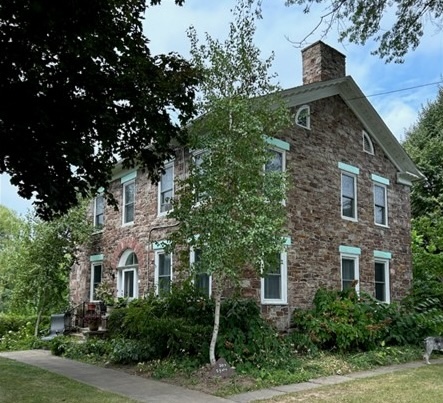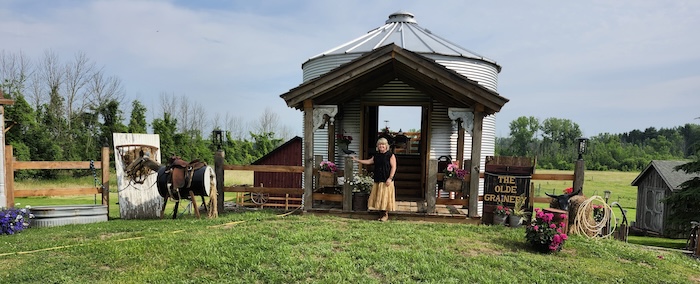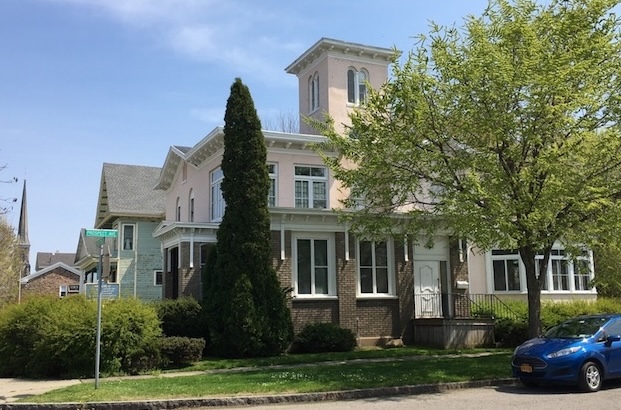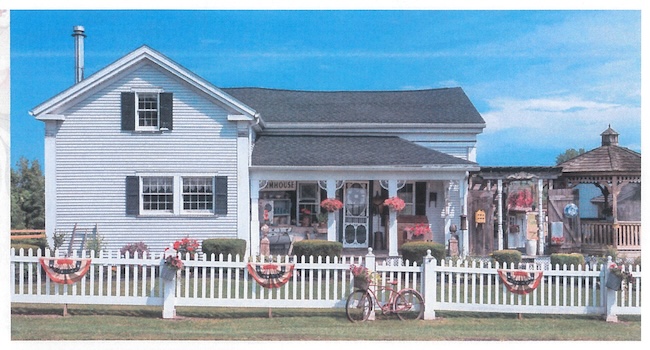Cobblestone announces sites for annual Architectural Tour of Homes

Photos courtesy of Cobblestone Museum: St. John’s Episcopal Church is at left and the Newell Shirt Factory/Hart House Hotel is at right. Both are historic sites in Medina.
The Cobblestone Society’s annual Architectural Tour of Homes is scheduled Oct. 18, featuring structures in two counties.
“The Cobblestone Museum has had a long history of home tours, starting in the 1960s,” said museum director Doug Farley. “They were originally all cobblestone structures, but in more recent years we have added a variety of construction.”
Historic homes and businesses are selected with a geographic focus to minimize the drive time between sites, Farley said. Bill Lattin will create a self-drive map that shows all six stops and indicates other points of interest along the route. All of the stops will be open for indoor tours, as well as viewing the outside and grounds. Hours are from noon to 5 p.m.
Tickets for the tour are on sale now at the museum, by phone at (585) 589-9013 or on the website. They will also be available the day of the tour at the Museum and at St. John’s Episcopal Church in Medina, which is one of the stops on the tour.
Sites included in the tour are the Isaac Bennett House, 203 State St., Medina’ Newell Shirt Factory/Hart House, 113 West Center St., Medina; St. John’s Episcopal church, 200 East Center St., Medina; Maple Crest Inn, 503 Prospect Ave., Medina; Sherry Wheatley’s featured home in Country Sampler; and Hartland Historical Society Cobblestone Schoolhouse, 9713 Seaman Rd. at Carmen Road, Middleport.

Delbert Young’s home will be featured on the tour.
The Isaac Bennett House, owned by Delbert Young, is the oldest Medina sandstone house in the village. It was built for Isaac Bennett in the late 1820s to early 1830s. Bennett procured stone for building purposes on the east side of Oak Orchard Creek. He owned several hundred acres of land spread on either side of Ridge Road.
The question is always asked, “Why does the front of the house face south, not toward State Street.” When the house was built, a street ran along that side of the house toward a canal bridge that is no longer there.
Young purchased the property from Rick and Marilyn Drilling. Retired Orleans County historian Bill Lattin stated, “This is one of Medina’s outstanding homes, both in its appearance and architectural integrity. It is nicely restored and well kept. There is a beautiful arboretum-like setting in the back yard with many unusual trees and plantings by the owner from seedlings.”
Newell Shirt Factory/Hart House Hotel is located in the former Robert H. Newell building, and had long been admired by Andrew Meier. For 86 years, the building was home to the Robert H. Newell Shirt Factory, which manufactured custom-made shirts, including many for customers like Winston Churchill, President Harding and Bob Hope. The Newell company left the historic building in 2004 and moved to Maple Ridge Road.. The business closed in 2007.
The village of Medina acquired the building after years of unpaid taxes. The three-story site had been neglected and was in disrepair when it was put up for sale in 2005, and Meier bought it. He was 25 at the time. “It had great bones and potential,” he said. “I knew the risks going in. It was an opportunity that came up that I could not pass up.”
He set about the task of methodically renovating and preserving the 14,000 square-foot building that originally opened in 1876, a site that was a hotel for its first 14 years before it became the Newell building.
The Hart House Hotel onsite includes rooms named for famous former Newell customers, including Churchill. There are also rooms named for legendary comedian Hope and Astor, a wealthy industrialist from New York City.
Several dining options are available at Hart House, including Factory Expresso, a coffee shop café with several lunch options; and the Shirt Factory Restaurant, featuring a menu with several dinner options.
St. John’s Episcopal Church is described by the Medina Sandstone Society accordingly:
“St. John’s church began as St. Luke’s Mission, a result of a rapidly growing village and a group of men who felt spiritual guidance was needed. The year was 1827 and the Erie Canal was bringing progress along its path.
“Construction was started in 1832 with a contract with Joseph Nixon for $3,585. Medina sandstone, quarried from the banks of the Erie Canal. Was used to construct this amazing structure. It is believed to be the building in Medina constructed of Medina sandstone. The building was completed, except for the tower, in 1838. On Christmas Eve 1838, St. John’s held its first service.
“In addition to its unique architecture, St. John’s is known for its beautiful stained glass windows and for its inclusion in Ripley’s Believe it or Not for being ‘the church in the middle of the road.’”
Not only is St. John’s the oldest church in Medina, it is the oldest Episcopal Church in Orleans County. For more than 180 years, St. John’s Church has had an important impact upon the community of Medina and continues to be an active parish today.
The Medina Sandstone Society inducted this outstanding example of Medina sandstone construction into its Sandstone Hall of Fame in 2015.
Visitors are advised that the stained glass windows, some from the 1800s, are the earliest ones in Orleans County.
The Maple Crest was the family home of Judge Henry Childs, later becoming known as the Maple Crest Inn. It is located at the corner of West Center Street and Prospect Avenue in Medina. The Maple Crest was built in 1860 for a Main Street merchant, who was a cousin of Susan B. Anthony.
Henry Augustine Childs was the eldest son of Levi and Ann Wright Childs, born in the town of Gaines on July 17, 1836. After finishing his early education at the Albion Academy, he started to fulfill his childhood ambition to become an attorney by studying law under Benjamin Bessac in Albion.
Four years later he was admitted to the bar and associated with the firm of Sickles and Graves in Medina. In 1868, Henry was elected Orleans County district attorney, an office he held for nine years, until 1877.
Judge Childs married Julia Freeman in 1859 and they had three children. Henry’s son Milford W. Childs married Pearl Cook, daughter of the S.A. Cook, a significant businessman in Medina history through his furniture business, S.A. Cook.
It came as no surprise to Orleans County residents when Henry’s name was placed in nomination for a Supreme Court justice position with the Western District of New York at the judicial convention in Buffalo in 1883. He was elected by a large majority and served with distinction from January 1884 until his death in May 1895. His jurisdiction covered Erie, Niagara, Orleans, Genesee, Wyoming, Allegany, Cattaraugus and Chautauqua counties.
Judge Childs’ local fame in the hamlet of Childs came about in 1897 when the residents of Fairhaven (as Childs was then known) wanted to open a U.S. Post Office in that name. that’s most likely when residents learned the “Fairhaven” was already taken. Postal regulations only permit one post office in any state to use the same name, and Fair Haven was already in juse in a small town near Oswego.
Judge Childs was selected for the hamlet’s namesake because folks felt he personified the high ideals and integrity of the community, all the while demonstrating the axion of “A local boy who makes good.”
The Maple Crest’s current owner, Rollin Hellner, remarked, “When I saw the Maple Crest, I knew I wanted to live there. I bought it in July 2022.” Hellner has made some repairs and restored the windows, original plasterwork and the parquet flooring. He has painted the outside in the home’s original color.
It was Margaret Raymond who purchased the Childs home in the 1930s and opened a restaurant in it, which she called “The Maple Crest.”
Sherry Wheatley’s residence at 10421 West Shelby Rd., Middleport, was featured in the spring and summer issues of Country Sampler Magazine.
Sherry and her late husband Jack purchased the house and 18 acres of land in 1985. The Greek Revival farmhouse was built in the 1840s. The Wheatleys spent more than two decades restoring the house and enhancing its appearl by adding a pergola, a gazebo and picket fencing.
Roofing, siding and windows were replaced and rooms were reconfigured, with a restoration that spanned 25 years of blood, sweat and tears. Twenty years into the restoration, a car crashed into the house and damaged the main structural beam. Undeterred. Sherry moved forward, stating, “It was a total gut job, but it has truly been a labor of love.”

Photo by Ginny Kropf: Sherry Wheatley stands in front of the grain bin she had converted into living space at her home on West Shelby Road.
A consummate collector, Sherry said her preferred style has evolved, and now she adores collecting and decorating with antiques. “I used to love modern design, but over the years my tastes have changed and now I favor primitives,” she said. Her collection of antiques spans more than 30 years of collecting. Her home and grounds represent unlimited imagination and repurposing.
Visitors are reminded while on site to be sure and check out Sherry’s collection of farm animals, including six chickens, seven goats, three sheep and two donkeys. She recently secured a grain bin from her sister’s farm, which she has had converted into a one-of-a-kind living area she calls “The Olde Grainery.”
The Hartland Historical Society Cobblestone Schoolhouse is nestled at the intersection of Seaman and Carmen Roads near Middleport. The former District #10 cobblestone schoolhouse stands as a proud relic of 19th century craftsmanship and community spirit. Built around 1845 in the Greek Revival style, it’s sturdy walls of field cobbles mark it as the earliest known cobblestone school in Niagara County.
For more than a century, this one-room schoolhouse served generations of local children, its modest structure echoing with lessons and laughter. After falling into disrepair, it was lovingly acquired by the
Hartland Historical Society in 1999, which undertook its restoration and transformed it into a museum and gathering space.
Today, it hosts monthly meetings and continues to educate visitors – not through textbooks, but through its enduring presence and the stories embedded in its stonework. Listed on the National Register of Historic Places, the schoolhouse is more than a building. It’s a testament to the region’s architectural heritage and the community’s commitment to preserving the past.







































































